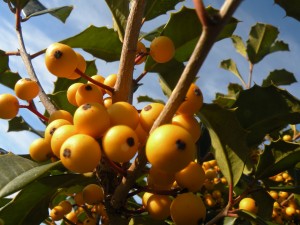Marilyn Young is the Horticulture Assistant at Wave Hill.
With the ideal of a garden as a year-round pleasure, it may be easy to delight in summer, but gardeners may be less certain how to sustain interest and color from fall through winter. There are lessons in the Wave Hill landscape to remedy this. All about the gardens and grounds, summer flowers give way to seed-bearing fruits as the warmest season falls away to autumn. Colorful berries are part of the regenerative process of nature and a good way to enliven the garden as winter comes. Feeding the birds, who contribute by digesting the protective shell and then doing a wonderful job scattering seed, provides an added treat.
Begin the berried treasure course in Wave Hill’s parking lot with the Pyracantha ‘Lo Boy’, commonly known as firethorn. Its thorny stems and brilliant orange berries persist almost all winter. In the shrub border by the entrance are two examples of a favorite berried shrub: the winterberry Ilex verticillata. The cultivar ‘Christmas Cheer’ was planted almost 30 years ago, and is paired with the similar ‘Winter Red’. The leafless branches of these deciduous hollies, covered with red berries, make a striking display in a snowy landscape. Three additional cultivars of the winterberry are planted in a colorful array in the semi-circular shrub border before Glyndor House. On the southeast corner of this house, the commanding presence of a pair of tall evergreen Ilex opaca are glorious as their berries ripen to a bright red against the shiny, green leaves.

Staffperson Betsy Ginn took both shots here at Wave Hill this winter. These lustrous yellow beads are Ilex opaca ‘Princeton Gold’. Look for them along the walkway between Wave Hill’s Perkins Visitor Center and the T.H. Everett Alpine House.
Now make your way north past the Perkins Visitor Center. Tucked in around this brick building are several Callicarpa dichotoma and C. bodinieri cultivars. Commonly called beautyberry, their delicate amethyst berries line the branches like clusters of small jewels. Planting several shrubs together in a small group is recommended to ensure cross-pollination and plentiful fruit. Also located here are favorites of Director of Horticulture Scott Canning: a trio of Viburnum nudum ‘Winterthur’ graces the Perkins Visitor Center; in the fall, their lustrous leaves turn red-purple, and their lingering fruits ripening to a dark blue hue.
Across the way to the left is the Viburnum bed. The border is usually alive with twittering birds sheltered and sustained by this stately group of shrubs. Viburnums are attractive in flower, in fruit and in autumn, when the leaves light up with fall colors. The red berries of Viburnum setigerum and V. dilatatum provide a veritable bird buffet.

Rosemary Verey, having seen the red berries of the Idesia polycarpa tree here and other places, notes in her volume The Garden in Winter that “bunches of berries were spectacular against a clear-blue winter sky.” These beauties can be found between our Aquatic Garden and the Shade Border.
Peppered about the Perkins Visitor Center, the Wild Garden, the Shade Border beyond the Aquatic Garden and the Herbert and Hyonja Abrons Woodland are several varieties of hollies, as well as viburnums, spice bushes and shadbushes. One place to search out berried shrubs is the area below Glyndor House—the Elliptical Garden and its adjacent slope with plantings of bayberries (Myrica pennsylvanica), winterberries and the Prunus maritima, commonly known as the beach plum.
This afternoon after a light snow, I took a walk up to the pergola that surrounds the Aquatic Garden, now closed for the season. The path heads around and then down a long corridor lined with several Euonymus japonicus ‘Chollipo’, festive with their variegated creamy yellow and green leaves and lovely little orange berries. This evergreen-lined walkway leads to a grand, red-berried Ilex x aquipernyi next to a pair of our older Idesia polycarpa, trees full of bright fruits the birds don’t seem to like.
There are many more shrubs and trees bearing berries throughout the grounds at Wave Hill, too numerous to mention them all here. Once you start seeking berried plants you will find them often. You may begin to enjoy this part of nature’s process even more than their flowering moment, and welcome some berried treasures into your own garden.
Bibliography for Suggested Reading:
Clarke, Ethne. Autumn Gardens. San Francisco: Soma Books (an imprint of Bay Books & Tapes). 1999.
Kingdon-Ward, F. Berried Treasure. Subtitled Shrubs for Autumn and Winter Colour in Your Garden. London: Ward, Lock & Co., Limited. 1954
Verey, Rosemary. The Garden in Winter. Boston & Toronto: Little, Brown and Company. 1988.
Wilder, Louise Beebe. The Garden in Color. New York: The Macmillan Company. 1937.

Leave a comment
Comments feed for this article